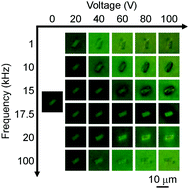Field strength and frequency tunable, two-way rotation of liquid crystal micro-particles dispersed in a liquid crystal host†
Abstract
Liquid crystal (LC) micro-particles are functional materials possessing anisotropies of LCs originating from their inner molecular alignment, and are fabricated by polymerizing pre-aligned rod-like molecules in the LC state. Here we demonstrate field strength and frequency tunable two-way rotation control of LC micro-particles in a LC host, and unravel its mechanism by theoretically calculating the contributing free energies. Cuboid-shaped micro-particles with inner molecular alignment along the long axis are fabricated via two-photon excited direct laser writing, and dispersed in a dual-frequency (DF) LC to be electrically driven by a voltage applied in the in-plane direction of the cell. Under an electric field, the particles rotate either clockwise or anticlockwise to align the inner molecular alignment parallel or perpendicular to the applied field; however, unlike conventional LCs, the rotation direction depends not only on the frequency, but also on the strength of the field. The complex motion is found to be the result of a delicate balance between the elastic energy of the host LC around the particle and the electrostatic energies of the host and the particle. Understanding complex rotational motion in LC/LC-particle composites is a step towards the development of advanced switching materials with superior performance.



 Please wait while we load your content...
Please wait while we load your content...